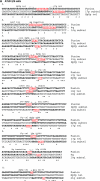Mre11 modulates the fidelity of fusion between short telomeres in human cells
- PMID: 22139912
- PMCID: PMC3315324
- DOI: 10.1093/nar/gkr1117
Mre11 modulates the fidelity of fusion between short telomeres in human cells
Abstract
The loss of telomere function can result in the fusion of telomeres with other telomeric loci, or non-telomeric double-stranded DNA breaks. Sequence analysis of fusion events between short dysfunctional telomeres in human cells has revealed that fusion is characterized by a distinct molecular signature consisting of extensive deletions and micro-homology at the fusion points. This signature is consistent with alternative error-prone end-joining processes. We have examined the role that Mre11 may play in the fusion of short telomeres in human cells; to do this, we have analysed telomere fusion events in cells derived from ataxia-telangiectasia-like disorder (ATLD) patients that exhibit hypomorphic mutations in MRE11. The telomere dynamics of ATLD fibroblasts were indistinguishable from wild-type fibroblasts and they were proficient in the fusion of short telomeres. However, we observed a high frequency of insertion of DNA sequences at the fusion points that created localized sequence duplications. These data indicate that Mre11 plays a role in the fusion of short dysfunctional telomeres in human cells and are consistent with the hypothesis that as part of the MRN complex it serves to stabilize the joining complex, thereby controlling the fidelity of the fusion reaction.
Figures




Similar articles
-
Cell cycle-dependent role of MRN at dysfunctional telomeres: ATM signaling-dependent induction of nonhomologous end joining (NHEJ) in G1 and resection-mediated inhibition of NHEJ in G2.Mol Cell Biol. 2009 Oct;29(20):5552-63. doi: 10.1128/MCB.00476-09. Epub 2009 Aug 10. Mol Cell Biol. 2009. PMID: 19667071 Free PMC article.
-
Mre11 ATLD17/18 mutation retains Tel1/ATM activity but blocks DNA double-strand break repair.Nucleic Acids Res. 2012 Dec;40(22):11435-49. doi: 10.1093/nar/gks954. Epub 2012 Oct 17. Nucleic Acids Res. 2012. PMID: 23080121 Free PMC article.
-
Fusion of short telomeres in human cells is characterized by extensive deletion and microhomology, and can result in complex rearrangements.Nucleic Acids Res. 2010 Apr;38(6):1841-52. doi: 10.1093/nar/gkp1183. Epub 2009 Dec 21. Nucleic Acids Res. 2010. PMID: 20026586 Free PMC article.
-
Ataxia-telangiectasia-like disorder (ATLD)-its clinical presentation and molecular basis.DNA Repair (Amst). 2004 Aug-Sep;3(8-9):1219-25. doi: 10.1016/j.dnarep.2004.04.009. DNA Repair (Amst). 2004. PMID: 15279810 Review.
-
Mystery of DNA repair: the role of the MRN complex and ATM kinase in DNA damage repair.J Appl Genet. 2008;49(4):383-96. doi: 10.1007/BF03195638. J Appl Genet. 2008. PMID: 19029686 Review.
Cited by
-
POLQ suppresses genome instability and alterations in DNA repeat tract lengths.NAR Cancer. 2022 Jun 29;4(3):zcac020. doi: 10.1093/narcan/zcac020. eCollection 2022 Sep. NAR Cancer. 2022. PMID: 35774233 Free PMC article.
-
Chromosome instability induced by a single defined sister chromatid fusion.Life Sci Alliance. 2020 Oct 26;3(12):e202000911. doi: 10.26508/lsa.202000911. Print 2020 Dec. Life Sci Alliance. 2020. PMID: 33106324 Free PMC article.
-
Telomeres and genomic evolution.Philos Trans R Soc Lond B Biol Sci. 2018 Mar 5;373(1741):20160437. doi: 10.1098/rstb.2016.0437. Philos Trans R Soc Lond B Biol Sci. 2018. PMID: 29335376 Free PMC article. Review.
-
Alternative end-joining mechanisms: a historical perspective.Front Genet. 2013 Apr 2;4:48. doi: 10.3389/fgene.2013.00048. eCollection 2013. Front Genet. 2013. PMID: 23565119 Free PMC article.
-
Alternative end joining, clonal evolution, and escape from a telomere-driven crisis.Mol Cell Oncol. 2015 Jan 28;2(1):e975623. doi: 10.4161/23723556.2014.975623. eCollection 2015 Jan-Mar. Mol Cell Oncol. 2015. PMID: 27308409 Free PMC article.
References
-
- de Lange T. Shelterin: the protein complex that shapes and safeguards human telomeres. Genes Dev. 2005;19:2100–2110. - PubMed
-
- Takai H, Smogorzewska A, de Lange T. DNA damage foci at dysfunctional telomeres. Curr. Biol. 2003;13:1549–1556. - PubMed
-
- Denchi EL, de Lange T. Protection of telomeres through independent control of ATM and ATR by TRF2 and POT1. Nature. 2007;448:1068–1071. - PubMed
-
- d'Adda di Fagagna F, Reaper PM, Clay-Farrace L, Fiegler H, Carr P, Von Zglinicki T, Saretzki G, Carter NP, Jackson SP. A DNA damage checkpoint response in telomere-initiated senescence. Nature. 2003;426:194–198. - PubMed
-
- Hopfner KP, Karcher A, Craig L, Woo TT, Carney JP, Tainer JA. Structural biochemistry and interaction architecture of the DNA double-strand break repair Mre11 nuclease and Rad50-ATPase. Cell. 2001;105:473–485. - PubMed
Publication types
MeSH terms
Substances
Grants and funding
LinkOut - more resources
Full Text Sources
Research Materials

